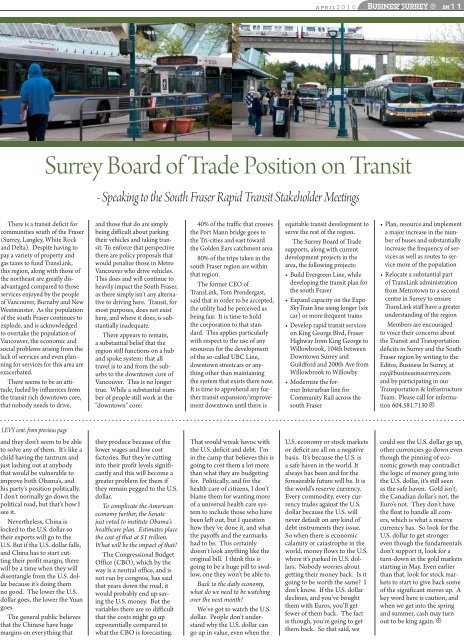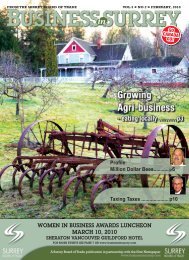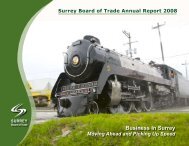Create successful ePaper yourself
Turn your PDF publications into a flip-book with our unique Google optimized e-Paper software.
APRIL2010BN11<strong>Surrey</strong> <strong>Board</strong> <strong>of</strong> <strong>Trade</strong> Position on Transit- Speaking to the South Fraser Rapid Transit Stakeholder MeetingsThere is a transit deficit forcommunities south <strong>of</strong> the Fraser(<strong>Surrey</strong>, Langley, White Rockand Delta). Despite having topay a variety <strong>of</strong> property andgas taxes to fund TransLink,this region, along with those <strong>of</strong>the northeast are greatly disadvantagedcompared to thoseservices enjoyed by the people<strong>of</strong> Vancouver, Burnaby and NewWestminster. As the population<strong>of</strong> the south Fraser continues toexplode, and is acknowledgedto overtake the population <strong>of</strong>Vancouver, the economic andsocial problems arising from thelack <strong>of</strong> services and even planningfor services for this area areexacerbated.There seems to be an attitude,fueled by influences fromthe transit rich downtown core,that nobody needs to drive,and those that do are simplybeing difficult about parkingtheir vehicles and taking transit.To enforce that perspectivethere are policy proposals thatwould penalize those in MetroVancouver who drive vehicles.This does and will continue toheavily impact the South Fraser,as there simply isn’t any alternativeto driving here. Transit, formost purposes, does not existhere, and where it does, is substantiallyinadequate.There appears to remain,a substantial belief that theregion still functions on a huband spoke system: that alltravel is to and from the suburbsto the downtown core <strong>of</strong>Vancouver. This is no longertrue. While a substantial number<strong>of</strong> people still work in the“downtown” core:40% <strong>of</strong> the traffic that crossesthe Port Mann bridge goes tothe Tri-cities and east towardthe Golden Ears catchment area80% <strong>of</strong> the trips taken in thesouth Fraser region are withinthat region.The former CEO <strong>of</strong>TransLink, Tom Prendergast,said that in order to be accepted,the utility had be perceived asbeing fair. It is time to holdthe corporation to that standard.This applies particularlywith respect to the use <strong>of</strong> anyresources for the development<strong>of</strong> the so-called UBC Line,downtown streetcars or anythingother than maintainingthe system that exists there now.It is time to apprehend any furthertransit expansion/improvementdowntown until there isequitable transit development toserve the rest <strong>of</strong> the region.The <strong>Surrey</strong> <strong>Board</strong> <strong>of</strong> <strong>Trade</strong>supports, along with currentdevelopment projects in thearea, the following projects:• Build Evergreen Line, whiledeveloping the transit plan forthe south Fraser• Expand capacity on the ExpoSkyTrain line using longer (sixcar) or more frequent trains• Develop rapid transit serviceson King George Blvd, FraserHighway from King George toWillowbrook, 104th betweenDowntown <strong>Surrey</strong> andGuildford and 200th Ave fromWillowbrook to Willowby• Modernize the formerInterurban line forCommunity Rail across thesouth Fraser• Plan, resource and implementa major increase in the number<strong>of</strong> buses and substantiallyincrease the frequency <strong>of</strong> servicesas well as routes to servicemore <strong>of</strong> the population• Relocate a substantial part<strong>of</strong> TransLink administrationfrom Metrotown to a secondcentre in <strong>Surrey</strong> to ensureTransLink staff have a greaterunderstanding <strong>of</strong> the regionMembers are encouragedto voice their concerns aboutthe Transit and Transportationdeficits in <strong>Surrey</strong> and the SouthFraser region by writing to theEditor, Business In <strong>Surrey</strong>, atray@businessinsurrrey.comand by participating in ourTransportation & InfrastructureTeam. Please call for information604.581.7130LEVY cont. from previous pageand they don’t seem to be ableto solve any <strong>of</strong> them. It’s like achild having the tantrum andjust lashing out at anybodythat would be vulnerable toimprove both Obama’s, andhis party’s position politically.I don’t normally go down thepolitical road, but that’s how Isee it.Nevertheless, China islocked to the U.S. dollar sotheir exports will go to theU.S. But if the U.S. dollar falls,and China has to start cuttingtheir pr<strong>of</strong>it margin, therewill be a time when they willdisentangle from the U.S. dollarbecause it’s doing themno good. The lower the U.S.dollar goes, the lower the Yuangoes.The general public believesthat the Chinese have hugemargins on everything thatthey produce because <strong>of</strong> thelower wages and low costfactories. But they’re cuttinginto their pr<strong>of</strong>it levels significantlyand this will become agreater problem for them ifthey remain pegged to the U.S.dollar.To complicate the Americaneconomy further, the Senatejust voted to institute Obama’shealthcare plan. Estimates placethe cost <strong>of</strong> that at $1 trillion.What will be the impact <strong>of</strong> that?The Congressional BudgetOffice (CBO), which by theway is a neutral <strong>of</strong>fice, and isnot run by congress, has saidthat years down the road, itwould probably end up savingthe U.S. money. But thevariables there are so difficultthat the costs might go upexponentially compared towhat the CBO is forecasting.That would wreak havoc withthe U.S. deficit and debt. I’min the camp that believes this isgoing to cost them a lot morethan what they are budgetingfor. Politically, and for thehealth care <strong>of</strong> citizens, I don’tblame them for wanting more<strong>of</strong> a universal health care systemto include those who havebeen left out, but I questionhow they’ve done it, and whatthe pay<strong>of</strong>fs and the earmarkshad to be. This certainlydoesn’t look anything like theoriginal bill. I think this isgoing to be a huge pill to swallow,one they won’t be able to.Back to the daily economy,what do we need to be watchingover the next month?We’ve got to watch the U.S.dollar. People don’t understandwhy the U.S. dollar cango up in value, even when theU.S. economy or stock marketsor deficit are all on a negativebasis. It’s because the U.S. isa safe haven in the world. Italways has been and for theforeseeable future will be. It isthe world’s reserve currency.Every commodity, every currencytrades against the U.S.dollar because the U.S. willnever default on any kind <strong>of</strong>debt instruments they issue.So when there is economiccalamity or catastrophe in theworld, money flows to the U.S.where it’s parked in U.S. dollars.Nobody worries aboutgetting their money back. Is itgoing to be worth the same? Idon’t know. If the U.S. dollardeclines, and you’ve boughtthem with Euros, you’ll getfewer <strong>of</strong> them back. The factis though, you’re going to getthem back. So that said, wecould see the U.S. dollar go up,other currencies go down eventhough the pinning <strong>of</strong> economicgrowth may contradictthe logic <strong>of</strong> money going intothe U.S. dollar, it’s still seenas the safe haven. Gold isn’t,the Canadian dollar’s not, theEuro’s not. They don’t havethe float to handle all comers,which is what a reservecurrency has. So look for theU.S. dollar to get strongereven though the fundamentalsdon’t support it, look for aturn-down in the gold marketsstarting in May. Even earlierthan that, look for stock marketsto start to give back some<strong>of</strong> the significant moves up. Akey word here is caution, andwhen we get into the springand summer, cash may turnout to be king again.








